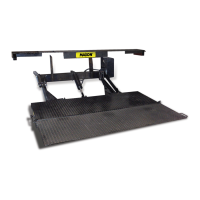11921 Slauson Ave. Santa Fe Springs, CA. 90670 (800) 227-4116 FAX (888) 771-7713
35
3. With platform on the ground, remove the pressure
hose and fi tting from the pump and replace it with
a 0-4000 PSI pressure gauge. Hold the switch in
the “UP” position. Adjust the relief valve on the
side of the pump until the gauge shows 3250 PSI
(FIG. 35-2). Remove gauge and reinstall pressure
hose.
4. Check for dirty pump motor relief valve. Clean if
necessary. Replace any worn out relief valve
parts.
5. Check the hydraulic cylinder. With the platform
on the ground, remove the breather plug or vent
line from the vent/down port of the cylinder (FIG.
35-1). Raise the platform even with the bed.
Allow pump motor to run two seconds more while
you watch for hydraulic fl uid at the vent/down port.
A few drops of hydraulic fl uid escaping the vent/
down port is normal; however, if it streams from
the vent/down port, piston seals are worn. Re-
place seals.
6. If pump cannot produce 3250 PSI can’t lift load
capacity with a minimum of 12.6 volts available,
the pump is worn and needs to be replaced.
LIFTGATE WILL NOT LIFT RATED CAPACITY
1. Use voltmeter to verify the battery shows 12.6 volts or more under load from pump
motor.
2. Check for structural damage and lack of lubrication. Replace worn parts.
PRESSURE
PORT
VENT/DOWN PORT
FIG. 35-1
NOTE: In most cases, you can avoid having to bleed the hydraulic system by cor-
rectly positioning Liftgate platform before opening hydraulic lines. Refer to following
procedure. Save time on the job and prevent accidental fl uid spills and hazards.
Keep dirt, water and other contaminants from entering the hydraulic system. Before
opening the hydraulic fl uid reservoir fi ller cap, drain plug and hydraulic lines, clean
up contaminants that can get in the openings. Also, protect the openings from
accidental contamination during maintenance.
CAUTION
PRESSURE
GAUGE
RELIEF
VALVE
ADJUST
SCREW
(REMOVE
PLUG)
FIG. 35-2

